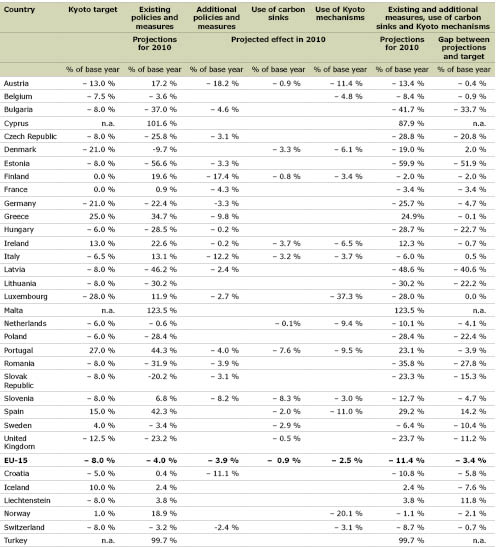The report, 'Greenhouse gas
emission trends and projections in Europe 2007', presents an
evaluation of data between 1990 and 2005. More importantly, the report
evaluates Member State projections of future greenhouse gas emissions
and provides a good indication of progress towards Kyoto targets. The
report is of particular relevance in the context of the rapidly
approaching 'first commitment period' of the Kyoto Protocol which runs
from 2008 to 2012 (1). (See notes)
EU-15 Emissions in 2005: According to the new report:
- EU-15 emissions decreased by 0.8 % between 2004 and 2005
- EU-15 emissions reached a level 2 % below the Kyoto base year
(2)
'On New Year's Day 2008 the serious business of Kyoto begins for
real. All available measures should now be implemented. Significant
emission reductions will take place through the emissions trading
scheme, the EU's 'cap and trade' programme for carbon (3).
As the scheme matures and expands we will see it establishing itself as
a blueprint for a global carbon market — an important part of any
post-Kyoto agreement,' said Professor Jacqueline McGlade, Executive
Director of the EEA.
Within the shared Kyoto target, each EU-15 Member State has a
differentiated emissions target, which can be achieved by a variety of
means. The 12 new EU Member States are not part of the joint EU-15
target but all, except Cyprus and Malta, have individual targets under
the Kyoto Protocol.
Looking ahead — the Road to Kyoto: Based on Member State
projections, the report says that existing domestic policies and
measures (4) will reduce EU-15 greenhouse gas emissions by a
net effect of 4.0 % below base-year levels. When additional domestic
policies and measures (i.e. those planned but not yet implemented) are
taken into account, the EU-15 could reduce emissions by an additional
3.9 %.
The projected use of Kyoto mechanisms (5) by ten of the
EU-15 will reduce emissions by a further 2.5 %. These governments have
set aside EUR 2.9 billion to pay for this. The use of carbon sinks,
such as planting forests to remove CO2, will reduce
emissions by an additional 0.9 %. As a result, the EU could even
achieve an 11.4 % reduction, the report says. All new Member States
with a target expect to meet their target.
Key instrument: The EU emissions trading scheme will bring
significant emission reductions between 2008 and 2012, according to the
report. It is expected to contribute a reduction of at least 3.4 %,
part of which is already reflected in some Member States projections.
This would represent a further reduction of at least 1.3 % to the total
of 11.4 % from base-year emissions in the EU-15.
Notes to the editor:
Background to the report
The report, prepared by the EEA and its European Topic Centre on Air
and Climate Change (ETC/ACC), complements the annual evaluation report
of the European Commission to the Council and European Parliament. For
more information see the Commission
website.
The EEA report covers 33 countries including:
- EU-15 Member States: Austria, Belgium, Denmark, Finland,
France, Germany, Greece, Ireland, Italy, Luxembourg, Netherlands,
Portugal, Spain, Sweden, United Kingdom.
- New Member States: Bulgaria, Cyprus, Czech Republic,
Estonia, Hungary, Latvia, Lithuania, Malta, Poland, Romania, Slovak
Republic, Slovenia.
- Acceding countries: Croatia, Turkey.
- Other EEA member countries: Iceland, Lichtenstein, Norway,
Switzerland.
An individual annex is provided for each country covered by the
report.
Data source: The report is based on data and information submitted by
the countries to the European Commission and the EEA by 1 June 2007.
For the past trends, it is entirely based on EEA Technical report No
7/2007 Annual
European Community greenhouse gas inventory 1990-2005 and inventory
report 2007. See
press release (15 June 2007).
- EU Kyoto Targets: The EU-15 has a Kyoto target to cut
greenhouse gas emissions by 8 % from base-year levels (see below) by
2012. Within this overall target, each EU-15 member state has a
differentiated reduction target; some should reduce emissions while
others are allowed a limited increase. New Member States have
individual targets except Cyprus and Malta, which have no targets.
Countries can achieve these targets by a variety of means.
- Base-year emissions: Under the Kyoto Protocol the GHG
emission level in the 'base year' is the relevant starting point for
tracking progress of domestic emissions for EU-15 and all Member States
which have a Kyoto target. The EU-27 does not have a Kyoto target and
an aggregated base year for the EU-27 is therefore not applicable in
any discussion of progress towards Kyoto targets. The base year is not
a 'year' per se, but the emission level from which emission reductions
will take place. For carbon dioxide, methane and nitrous oxide 1990 is
used as the 'base year' for all EU-15 Member States. But for
fluorinated gases, the EU-15 Member States can choose to use the
emission levels in 1995 instead. Twelve of the 15 Member States have
chosen to use 1995 as their base year for fluorinated gas emissions. In
practice, EU-15 base-year emissions can be considered close to 1990
emissions.
- EU Emissions Trading Scheme: The EU Emissions Trading Scheme
is the European Union's climate change policy tool, which helps
industries to cut their CO2 emissions in a cost-effective
way. It requires a cap on emissions for all large CO2
emission sources. In the EU-15, the ETS is estimated to cut 3.4 % from
base-year emissions.
- Domestic policies and measures: Domestic policies and
measures take place within the national boundaries of the country and
include: the promotion of electricity from renewable energy;
improvements in energy efficiency; promotion of biofuels in transport;
reduction of carbon dioxide emissions from cars; recovery of gases from
landfills and reduction of fluorinated gases.
- Kyoto Mechanisms: The Kyoto Mechanisms help developed
countries to achieve their Kyoto targets by gaining credits through
carbon cutting activities in other countries. They also help the
transfer of low-carbon technologies to other countries. The projected
use of Kyoto mechanisms by ten of the EU-15 Member States will reduce
emissions by 2010 by 2.5 % from base-year levels. These countries are
Austria, Belgium, Denmark, Finland, Ireland, Italy, Luxembourg, The
Netherlands, Portugal and Spain. For more information on Kyoto
mechanisms see the UNFCCC
website.
Overview of progress for EU Member States and
other EEA member countries

Notes: National projections provided by 1 June 2007 have been taken
into account in this report.
- Projected net removal from carbon sink activities (land-use change
and forestry).
- Denmark projects it will reach its target by initiating new
national climate initiatives, although these have not yet been
identified.
- In July 2007, Spain adopted a Plan of Urgent Measures against
Climate Change. Spain plans that these measures will allow it to fulfil
its commitments under the Kyoto Protocol.
Greenhouse gas emissions projections for 2010 in
Europe

About the European Environment Agency
(EEA):
The EEA is based in Copenhagen. The agency aims to help achieve
significant and measurable improvement in Europe's environment through
the provision of timely, targeted, relevant and reliable information to
policy makers and the public.
Contact information:
Brendan Killeen
Press Officer
Phone: +45 33 36 72 69
Mobile: +45 23 68 36 71
E-mail: brendan.killeen@eea.europa.eu
Marion Hannerup
Head of Communications and Corporate Affairs
Phone: +45 33 36 71 60
Mobile: +45 51 33 22 43
E-mail: marion.hannerup@eea.europa.eu



Document Actions
Share with others